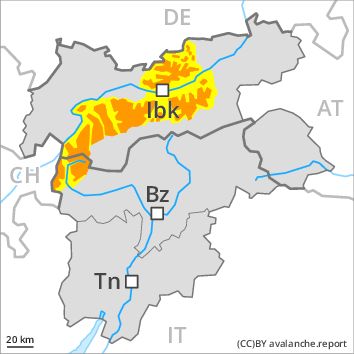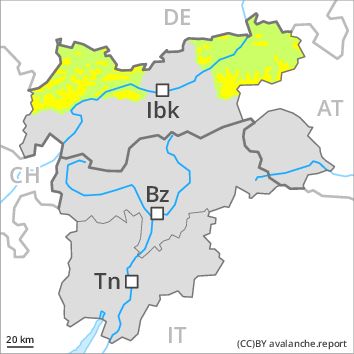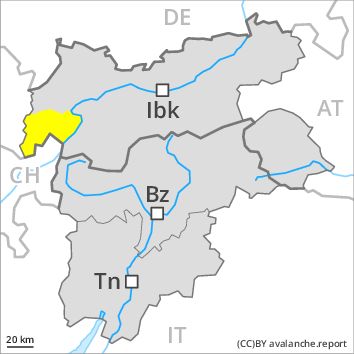Regions
Sexten Dolomites, Latemar, Southern Adamello, Adamello - Presanella, Northern Brenta - Peller, Bondone and Stivo, Folgaria - Laverone, Southern Brenta, Southern Lagorai, Northern Lagorai, Schnals Ridge, Southern Stubai Alps, Southern Zillertal Alps and High Tauern, Saldurn-Mastaun Ridge, Texel Mountains, Sarntal Alps, Western Pfunderer Mountains, Maddalene, Pine' - Mocheni Valley, Eastern Pfunderer Mountains, Durreck Range, Weißkugel Range, Western Rieserferner Mountains, Gurgler Range, Western Deferegger Alps, Central Stubai Alps, Ortler Range, Northern Zillertal Alps, Ulten Valley, Venediger Range, Eastern Nonsberger Alps, Eastern Rieserferner Mountains, Northern Dolomites of Fiemme, Glockner Range, Gröden Dolomites, Primiero - Pale di S. Martino, Eastern Deferegger Alps, Prags Dolomites, Prealps, Schober Mountains, Cembra Valley, Lienzer Dolomites, Vallarsa, Western Nonsberg Alps, Fassa Valley, Sole, Pejo and Rabbi, Ledro Valley, Paganella, Marzola - Valsugana

Danger level
Danger Level 4 - High
Avalanche Problem
Wind-drifted snow above the treeline, N-NE-E-SE-S-SW-W-NW
Gliding snow above 2500m, N-NE-E-SE-S-SW-W-NW

As a consequence of fresh snow and stormy weather a critical avalanche situation will be encountered in some regions. Gliding avalanches and dry slab avalanches are the main danger.
Natural avalanches must be expected.
On steep grassy slopes numerous medium-sized and, in many cases, large gliding avalanches are to be expected below approximately 2500 m.
In addition a substantial danger of dry slab avalanches exists, in particular above the tree line. Numerous medium-sized to large avalanches are to be expected. These can be released easily. The prevalence of avalanche prone locations and likelihood of triggering will increase with altitude. As the snowfall becomes more intense the prevalence and size of the avalanche prone locations will increase during the course of the night, in particular in the northeast.
Additionally in some places dry avalanches can also be released in near-ground layers and reach very large size in isolated cases during the course of the night. This applies in all aspects in high Alpine regions.
Outside marked and open pistes a critical avalanche situation will prevail.
Snowpack
dp 6: cold, loose snow and wind
dp 2: gliding snow
Over a wide area 40 to 80 cm of snow, and even more in some localities, has fallen thus far. Over a wide area 30 to 50 cm of snow. will fall until the early morning, especially in the northeast. The wind will be strong to storm force. As a consequence of fresh snow and a storm force southerly wind, extensive wind slabs will form in all aspects.
The snowpack will be generally prone to triggering. Over a wide area fresh snow and wind slabs are lying on soft layers, especially above the tree line. The old snowpack will be unstable in high Alpine regions. Dry avalanches can be released in near-ground layers.
The snowpack will be moist at low and intermediate altitudes.
Tendency
A critical avalanche situation will persist. High, level 4.
Regions
Western Tuxer Alps, Karwendel Mountains, Eastern Tuxer Alps, Glockturm Range, Val Müstair Alps, Langtaufers, Northern Oetz and Stubai Alps

Danger level
Danger Level 3 - Considerable above the treeline
Danger Level 2 - Moderate above the treeline
Avalanche Problem
Wind-drifted snow above the treeline, N-NE-E-SE-S-SW-W-NW
Gliding snow above 2500m, N-NE-E-SE-S-SW-W-NW

Fresh wind slabs above the tree line. Gliding avalanches and snow slides below approximately 2500 m.
The fresh wind slabs represent the main danger. These can be released by a single winter sport participant in some cases in all aspects above the tree line. They are mostly small. The avalanche prone locations are barely recognisable, even to the trained eye.
In addition a certain danger of gliding avalanches and snow slides exists, in the regions exposed to a lot of fresh snow especially.
Snowpack
dp 6: cold, loose snow and wind
dp 2: gliding snow
As a consequence of a strong to storm force southerly wind, mostly small wind slabs formed since Thursday above the tree line. In some places wind slabs are lying on soft layers. The snowpack will be moist at low and intermediate altitudes.
Tendency
The fresh wind slabs must be evaluated with care and prudence in all aspects at intermediate and high altitudes.
Regions
Brandenberg Alps, Western Kitzbühel Alps, Wilder Kaiser Mountains - Waidring Alps, Eastern Kitzbühel Alps, Western Lechtal Alps, Central Lechtal Alps, Grieskogel Mountains, Allgäu Alps, Eastern Lechtal Alps - Ammergau Alps, Mieming Mountains

Danger level
Danger Level 2 - Moderate above the treeline
Danger Level 1 - Low above the treeline
Avalanche Problem
Wind-drifted snow above the treeline, N-NE-NW
Gliding snow above 2500m, N-NE-E-SE-S-SW-W-NW

Fresh wind slabs above the tree line. Gliding avalanches and snow slides below approximately 2500 m.
The fresh wind slabs represent the main danger. These can be released by a single winter sport participant in some cases in particular on northwest to north to northeast facing aspects above the tree line. They are mostly small.
Slides can occur on steep grassy slopes, in the regions exposed to heavier precipitation especially.
Snowpack
dp 6: cold, loose snow and wind
dp 2: gliding snow
As a consequence of a strong to storm force southerly wind, mostly small wind slabs formed since Thursday above the tree line. In some places wind slabs are lying on soft layers. The snowpack will be moist at low and intermediate altitudes.
Tendency
Slight increase in danger as the precipitation becomes more intense.
Regions
Western Verwall Mountains, Eastern Verwall Mountains, Silvretta, Samnaun Mountains

Danger level
Danger Level 2 - Moderate
Avalanche Problem
Wind-drifted snow above the treeline, N-NE-E-SE-S-SW-W-NW
Gliding snow above 2500m, N-NE-E-SE-S-SW-W-NW

Fresh wind slabs above the tree line. Gliding avalanches and snow slides below approximately 2500 m.
The fresh wind slabs represent the main danger. These can be released by a single winter sport participant in some cases in all aspects above the tree line. They are mostly small but can in some cases be released easily.
In addition a certain danger of gliding avalanches and snow slides exists, in the regions exposed to a lot of fresh snow especially.
Snowpack
dp 6: cold, loose snow and wind
dp 2: gliding snow
As a consequence of a strong to storm force southerly wind, mostly small wind slabs formed since Thursday above the tree line. In some places wind slabs are lying on soft layers. The snowpack will be moist at low and intermediate altitudes.
Tendency
Slight increase in avalanche danger as the precipitation becomes more intense.




